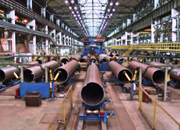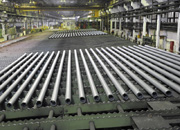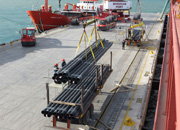While detailed process descriptions specifically for this particular size (323.9*10.31)
straight seam steel pipe may be rare, we can infer its general flow based on the general production process of straight seam steel pipes. The production process of straight seam steel pipes typically includes the following main steps:
First, Raw Material Preparation for Straight Seam Steel Pipes.
Steel Plate Selection: First, suitable steel plates must be selected as raw materials. The material, thickness, and width of the steel plate must be designed according to the specifications of the final product. For 323.9*10.31 welded pipes, steel plates with appropriate width and thickness will be selected.
Second, Steel Plate Pre-treatment for Straight Seam Steel Pipes.
- Plate Inspection: Ultrasonic testing is performed on the entire steel plate to detect internal defects.
- Edge Milling: The two edges of the steel plate are double-sided milled using an edge milling machine to achieve the required plate width, edge parallelism, and bevel shape.
- Pre-bending: The edges of the steel plate are pre-bent using a pre-bending machine to give them a certain curvature for subsequent forming.
Third, Forming of Straight Seam Steel Pipes.
- Forming Process: Depending on the forming method of the straight seam steel pipe (e.g., high-frequency straight seam steel pipe or submerged arc welded straight seam steel pipe), appropriate forming equipment is used. For high-frequency straight seam steel pipes, the weld seam may be formed directly by heating and pressing the steel plate edges with high-frequency current; while for submerged arc welded straight seam steel pipes, the steel plate may first be pressed into a specific shape (e.g., JCO forming) before welding.
- Specific Steps (Taking JCO forming as an example): On a JCO forming machine, one half of the pre-bent steel plate is first pressed into a "J" shape through multiple step-by-step stampings. Then, the other half of the steel plate is similarly bent and pressed into a "C" shape, finally forming an open "O" shape.
Fourth, Welding of Straight Seam Steel Pipes.
- Pre-welding: For submerged arc welded straight seam steel pipes, pre-welding may be performed first after forming. This involves continuous welding using gas shielded welding (MAG) to fix the weld position.
- Internal and External Welding: Internal and external welding are then performed. Internal welding typically uses longitudinal multi-wire submerged arc welding (up to four wires) on the inside of the steel pipe. External welding may be performed on the outside of the steel pipe.
Fifth, Inspection and Post-processing of Straight Seam Steel Pipes.
- Weld Inspection: The weld is inspected using ultrasonic and X-ray methods to ensure weld quality.
- Diameter Expansion: The welded pipe is expanded to improve dimensional accuracy and internal stress distribution.
- Hydrostatic Testing: Each welded pipe is inspected on a hydrostatic testing machine to ensure it meets the standard test pressure requirements.
- Pipe End Machining: The inspected and qualified pipes undergo end machining, such as chamfering, to achieve the required pipe end bevel dimensions.
- Corrosion Protection and Coating: Corrosion protection and coating treatments are applied to the steel pipes according to user requirements.
It should be noted that the above steps are an overview of the general production process for straight seam steel pipes and may vary depending on specific product specifications, manufacturers, and equipment conditions. For straight seam steel pipes of the specific size 323.9*10.31, the production process may be appropriately adjusted based on the above.
 Threeway Steel is known as a professional supplier engaged in manufacturing and distributing a wide range of steel pipe, and our headquarter located the central part of China – Hunan and six associated factories throughout China.
Threeway Steel is known as a professional supplier engaged in manufacturing and distributing a wide range of steel pipe, and our headquarter located the central part of China – Hunan and six associated factories throughout China.
 Threeway Steel is known as a professional supplier engaged in designing, manufacturing and distribution of a wide range of steel products with the headquarter located the central part of China – Hunan and six associated factories throughout China.
Threeway Steel is known as a professional supplier engaged in designing, manufacturing and distribution of a wide range of steel products with the headquarter located the central part of China – Hunan and six associated factories throughout China.
 Threeway Steel is known as a professional supplier engaged in designing, manufacturing and distribution of a wide range of steel products with the headquarter located the central part of China – Hunan and six associated factories throughout China.
Threeway Steel is known as a professional supplier engaged in designing, manufacturing and distribution of a wide range of steel products with the headquarter located the central part of China – Hunan and six associated factories throughout China.
 Threeway Steel is known as a professional supplier engaged in designing, manufacturing and distribution of a wide range of steel products with the headquarter located the central part of China – Hunan and six associated factories throughout China.
Threeway Steel is known as a professional supplier engaged in designing, manufacturing and distribution of a wide range of steel products with the headquarter located the central part of China – Hunan and six associated factories throughout China.
 Threeway Steel is known as a professional supplier engaged in designing, manufacturing and distribution of a wide range of steel products with the headquarter located the central part of China – Hunan and six associated factories throughout China.
Threeway Steel is known as a professional supplier engaged in designing, manufacturing and distribution of a wide range of steel products with the headquarter located the central part of China – Hunan and six associated factories throughout China.

